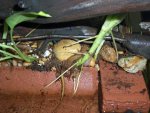Myeager15y
New member
- Joined
- Sep 11, 2011
- Messages
- 16
- Reaction score
- 0
I have had a Southern Two-lined Salamander (Eurycea cirrigera) for about a year now. From what I understand I have a female wc and at first new nothing about this salamander.
So far I have observed that it enjoys being close to moving water. They are real good swimmers and pose almost no risk for drowning. Or at least this one doesnt seem to mind water. Granted it really only goes into the water to hunt and to mate I understand.
They are mainly terestrial, nocturnal, they climb really well, and will only eat live food. (small prey crickets, isopods, blackworms) They only swim occassional, and when they do they can catch your smaller tropical fish (non-agressive type) and will eat snails and any baby fish.
Normaly behavior I would say consists of hiding durring the day and hunting at night. This one loves to get into the places in the tank that are hard to get to. They are fast and will hide as soon as the light comes on.
If anyone has experience or know any further info on this species let me know please.
So far I have observed that it enjoys being close to moving water. They are real good swimmers and pose almost no risk for drowning. Or at least this one doesnt seem to mind water. Granted it really only goes into the water to hunt and to mate I understand.
They are mainly terestrial, nocturnal, they climb really well, and will only eat live food. (small prey crickets, isopods, blackworms) They only swim occassional, and when they do they can catch your smaller tropical fish (non-agressive type) and will eat snails and any baby fish.
Normaly behavior I would say consists of hiding durring the day and hunting at night. This one loves to get into the places in the tank that are hard to get to. They are fast and will hide as soon as the light comes on.
If anyone has experience or know any further info on this species let me know please.
Last edited by a moderator:

